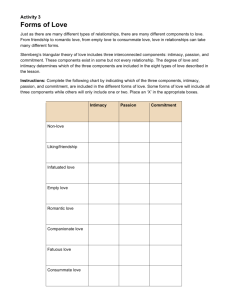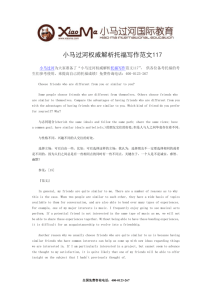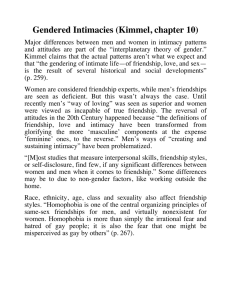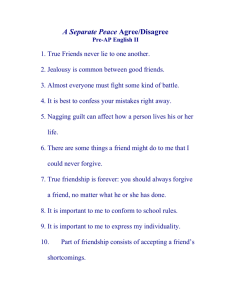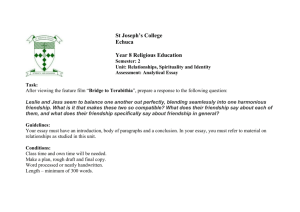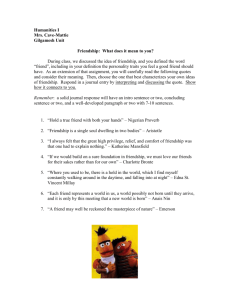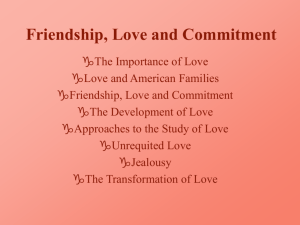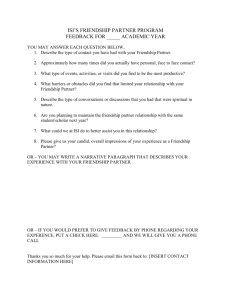Friendship, Love & Commitment
advertisement
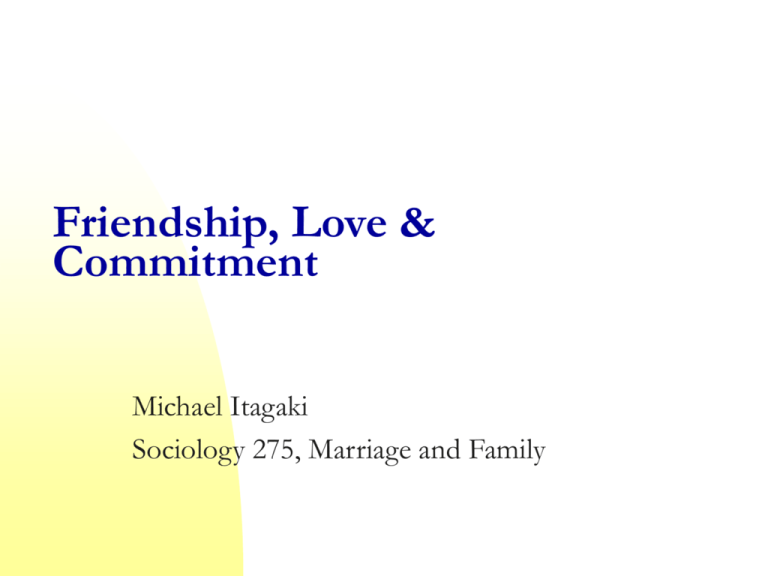
Friendship, Love & Commitment Michael Itagaki Sociology 275, Marriage and Family The Importance of Love Love is essential. Love is both a feeling and an activity. The paradox of love Perfection vs. Meaning Love and American Families Foundation for marriage, criterion for spousal selection. Character of love. Love is the criterion for choosing a spouse. Love is uncontrollable and irrational. Homogamy The tendency to marry people much like oneself. Friendship, Love and Commitment Friendship Foundation Love Draws people together, sustains them Commitment Stable for love and commitment factors that maintain the relationship Love and commitment are related, but can exist without the other. Friendship, Love and Commitment Friendship and love bind us together Best friends: similar to spouse and lover relationships Lovers covet exclusiveness Friendship appears to be the foundation for a strong love relationship. Friendship, Love and Commitment Gender differences and love Differences in number and nature of friendships Men are more open in cross-sex friendships Men fall in love more quickly than women Friendship, Love and Commitment Gender exceptions: Love between equals Peer marriage: Built on equity, equality and deep friendship. Deep friendship • Valuing companionship • Produces intimacy and mutual respect Central Attributes of Love Trust Caring Honesty Friendship Respect Concern for the other’s well-being Loyalty Commitment Acceptance of the other Supportiveness Wanting to be with the other Interest in the other Central Attributes of Commitment Loyalty Responsibility Living up to your word Faithfulness Trust Being there for the other in good and bad times Devotion Reliability Giving your best effort Supportiveness Perseverance Concern about the other’s well-being Feelings Identifying Love Rubin’s four feelings identifying love: 1. 2. 3. 4. Caring for the other Needing the other Trusting the other Tolerating the other Friendship, Love and Commitment Other Research on Love Romantic love expressed by: Verbally/physically expressing affection Self disclosing Giving material/non-material evidence In love? More positive world view Behaviors Expressing Love Swensen’s expressions of romantic love: 1. Verbally expressing affection 2. Self-disclosing, revealing intimate facts 3. Offer emotional support 4. Expressing nonverbal feelings (happiness, etc…) 5. Giving material evidence: gifts, favors 6. Physically expressing love Important Factors in Commitment 1. 2. 3. Balance of costs to benefits Normative inputs: Values about love Structural constraints: Roles and expectations Observations, Research on Commitment 1. 2. 3. 4. Commitments are more likely to endure in marriage Commitments are more likely to endure in heterosexual relationships Enduring marriage is not always a happy one Overlap between love and commitment Wheel Theory of Love Love develops and is maintained through four processes: 1. Rapport 2. Self-revelation 3. Mutual dependency 4. Fulfillment of intimacy needs Reiss’s Wheel Theory of Love Triangular theory of love Views love as consisting of three components: Intimacy Ten Signs of Intimacy 1. 2. 3. 4. 5. Wanting to promote your partner’s welfare. Feeling happiness with your partner. Holding your partner in high regard. Being able to count on your partner in time of need. Being able to understand each other. Ten Signs of Intimacy 6. 7. 8. 9. 10. Sharing yourself and your possessions with your partner. Receiving emotional support from your partner. Giving emotional support to your partner. Being able to communicate with your partner about intimate things. Valuing your partner’s presence in your life. Triangular theory of love Views love as consisting of three components: Intimacy Passion Decision/commitment Triangular Theory of Love Commitment, Passion, and Intimacy Type Commitment Passion Intimacy Liking - - + Infatuation – + – Empty love + – – Romantic love Companionate love Fatuous love – + + + – + + + – Consummate love + + + Attachment Theory of Love Views love as being similar in nature to attachments we form as infants. The attachment (love) styles of both infants and adults are: Secure Anxious/ambivalent Avoidant Styles of Unrequited Love Cyrano style: Desire for a relationship regardless of how hopeless. Anxious/ambivalents Giselle style: Misperception that a relationship is likely to develop. Secure Don Quixote style: Desire to be in love. Avoidants Jealousy Occurs because of a partner’s real, imagined, or likely involvement with a third person. Most likely in committed relationships because of the presumed “specialness” of the relationship. Fear of loss, coupled with insecurity, increases the likelihood of jealousy.
